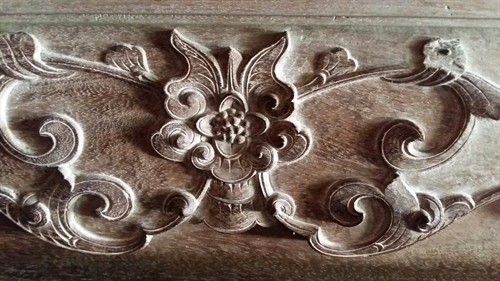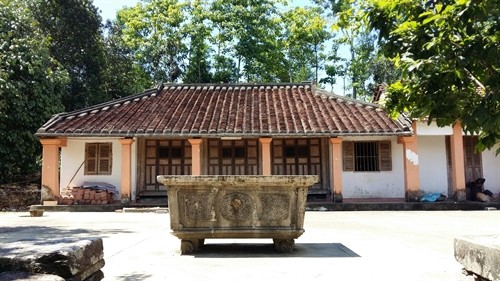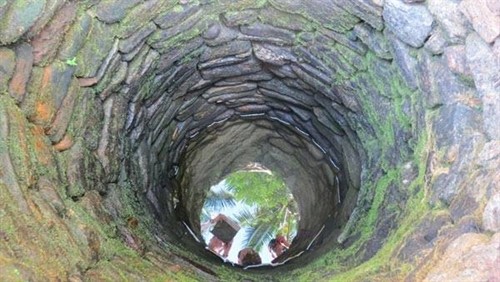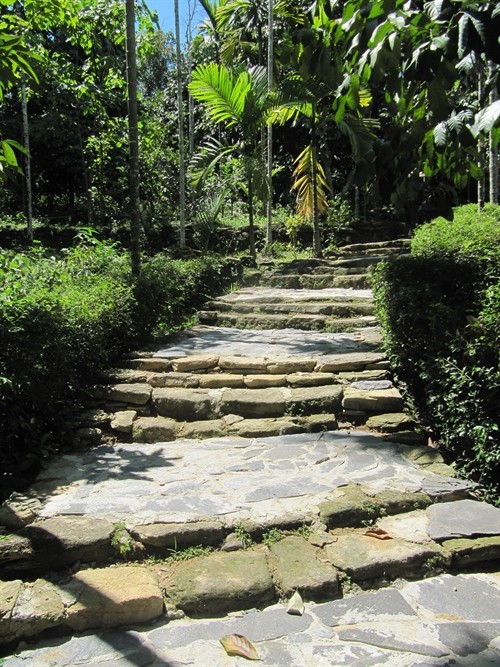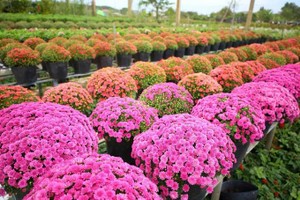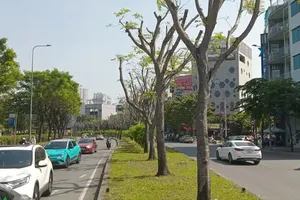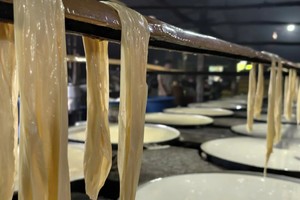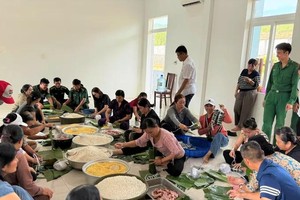Lộc Yên Village, situated in the midlands of Quảng Nam Province’s Tiên Phước District, is known for its centuries-old houses with stone pathways. In addition to the houses, nature and the lifestyle of the villagers have been preserved for over 200 years. Generations still maintain their ancestors’ priceless treasures over time, Công Thành reports.
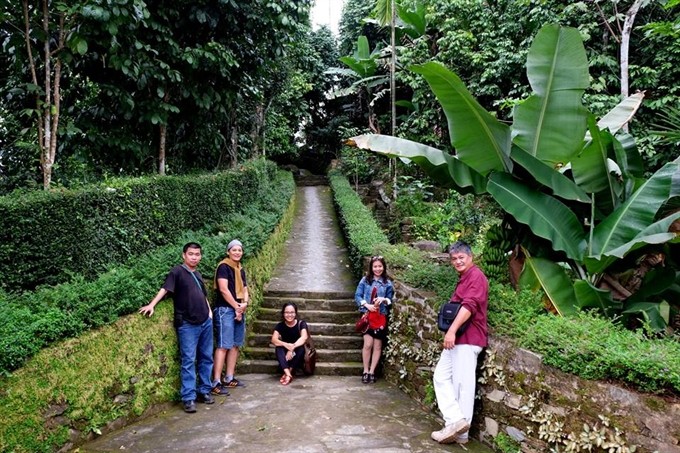
Born into a family of four sisters and a brother, Nguyễn Thị San, 65, still lives in her ancient house in Lộc Yên Village in Tiên Cảnh Commune.
The house, which was built and designed as a rường house (a structure with timber rafters and columns), is one of eight 17th-century houses that have been preserved in the central province of Quảng Nam’s Tiên Phước District, 40km northeast of Tam Kỳ City.
The village is a rare site, as it maintains its ancient architecture, protects its rural landscape and maintains its customs that have endured for centuries.
San said the house was one of five houses given by her great-great-grandfather to his five sons as inheritances, but only two have been restored.
“I was told by my father that the house was built by Nguyễn Đình Hoằng, a rich man in the village, in early 1828,” San said. “The house was built along with a well located downhill from the house near the gate.
“The house is on a hill with its front facing a paddy field, while the entrance is tiled with rocks – a popular design of most houses in the village.”
She said the house, which was built with 36 timber columns that were logged from jackfruit trees, was inherited by her younger brother, Nguyễn Đình Mẫn, but she still lives in the house, since she was born there, and looks after it.
The house was that were about 40 years old.
The girders, beams and rafters were sculpted with patterns of dragons, deer, squirrels and flowers by skilful carpenters from the Vân Hà carpentry village (now in Tam Thành Commune) in Phú Ninh District.
San said that the carvings on the rafters and ridge beams were the main features that distinguished between the houses of the wealthy and peasants.
She said the main hall of the house was used as a living room and for ancestor worship.
San remembered that the house’s roof had been built with two layers – a mixture of chopped straw with a clay base and thatch cover, which helped to cool the house naturally. However, the roof was replaced by a timber lath base and clay tiles for longer use.
She said masons did not tile or plaster the floor, but they levelled the clay floor.
Nguyễn Đình Hoan also preserves a 200-year-old house located on the highest hill in the village he inherited from his grandfather.
“Masons levelled a large area on the upper hill to serve as the foundation of the house,” Hoan said. “Rocks were used to tile the entrance and reinforce the terraced mountain sides to prevent erosion.”
Hoan, a fourth-generation member of the Nguyễn Đình family, said he endured hardships to preserve the house – his most precious treasure that was passed down from his late great-great-grandfather.
“We make our living by farming and gardening, but I still keep the house as a great moral support to overcome the difficulties of life and wartime,” Hoan said. “I’m still proud that the treasure of the Nguyễn Đình clan has been well preserved.
“We are unable to repair rotten rafters and girders due to a lack of funds. Retiling would cost us VND40 million or 50 million, as old tile designs are no longer produced, while handmade clay tile production costs so much,” Hoan said, adding that woodwork would be even more expensive.
He said he is unable to find decades-old jackfruit trees for logging.
Hoan’s wife, Nguyễn Thị Kim Sương, 54, said the house, which was listed as a provincial heritage site in 2005, is now a landmark for travellers and researchers of old architecture.
Sương, however, criticised the latest restoration in 2013, which she said altered its original design to an extent.
She said the original colour of the wooden pillars was dark brown, but the new timber is light brown.
“The entrance, which used to have steps made from rugged stones, has been turned into a flat surface with stone tiles, and it’s slippery in the rainy season,” Sương said.
Despite these changes, she said most of the main structure, including columns and girders, were kept in their original condition.
She said a new house was built beside the old one to accommodate her family of three children.
“We preserve the old house for ancestor worship and for tourists, while we live in convenience in the new house,” the 54-year-old woman said.
She said most old house owners still use centuries-old dug wells because the environment is protected well by local residents.
Harmony with nature
Professor Hoàng Đạo Kính, an architect specialising in heritage site restoration, said Lục Yên is a unique village in Việt Nam.
“It’s amazing,” Kính said. “Villagers set up rocks from generation to generation to build up rock walls and paths, not only for easy access, but to create unique scenery and architecture that lasts centuries. The value of old architecture is a priceless treasure.
“Villagers have preserved their habitat in harmony with nature and the terrain of the midlands, valleys, paddy fields, rocks and river. They do not disturb the natural condition or destroy house structures, farms or gardens.”
He said rows of trees breathe fresh air into the village and shield it from the scorching summer heat.
Kính said the village should develop tourism to preserve the heritage of the ancient houses in the long-term, but said it would also need strict control and management to make good use of tourism funds for restoration projects.
The administration of Tiên Phước District has planned a community-based tourism service in Lộc Yên.
“We have called for investment from travel agencies in connection with tour services at the village and destinations in neighbouring provinces,” said Vice Chairman of the district’s People’s Committee Phùng Văn Huy.
“The benefits from tourism could help local people preserve the old houses better and longer, while the district could map out new destinations to attract tourists,” Huy said.
Huy said the district also plans to develop a farm produce processing centre to create a ‘green and clean’ brand of produce, including jackfruit, banana and hot pepper.
He said 90 per cent of the population makes a living on rice farming and gardening, so community-based programmes would be a suitable solution to boost sustainable development in the near future.
He said the district has been seeking funds for infrastructure projects to help lure tourism investors.
“We acknowledge that ancient houses in the village and the lifestyle have huge potential for tourism development,” Huy said. “However, it needs a careful master plan to preserve these houses with the help of local residents.”
Đặng Công Dung, head of the district’s Culture and Information Office, said local residents are not yet equipped with hospitality and reception skills to host tourists.
He said the village is now conveniently connected with the provincial capital, Tam Kỳ, via a public bus route, while off-road adventurers could travel to the village by motorbike from Hội An and Đà Nẵng.
“We just offer familiarisation (FAM) trips for travel agencies in the village. It needs time to set up services appropriate for hosting tourists,” he said. “Of course, local residents are not yet ready for tourism; it’s a very new service for them to shift from farming to hospitality.”
San said local residents are hospitable and welcome all visitors.
“We are very open and friendly – a good tradition of most villagers,” San said. “We love peace and tranquil scenery, as well as old houses. We hope more people will come to know our village, and that Lộc Yên Village will be listed as a top destination in Quảng Nam and the central region in general.”
Dung also said the village will be introduced at the Quảng Nam Heritage Festival in 2017 along with world heritage sites in Hội An, Mỹ Sơn Sanctuary and world biosphere Chàm Island in the province.
